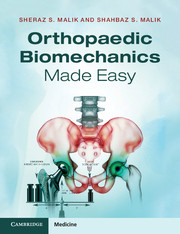Book contents
- Frontmatter
- Dedication
- Contents
- Contributors
- Epigraph
- Preface
- Acknowledgements
- Part I Orthopaedic biomaterials and their properties
- Part II Engineering theory applied to orthopaedics
- Part III Clinical biomechanics
- 6 Biomechanics of the hip and total hip replacement
- 7 Biomechanics of the knee and total knee replacement
- 8 Biomechanics of the shoulder
- 9 Biomechanics of the elbow
- 10 Biomechanics of the spine
- 11 Biomechanics of the ankle and foot
- 12 Biomechanics of fracture fixation
- 13 Trauma meeting: case-based discussions
- Index
11 - Biomechanics of the ankle and foot
from Part III - Clinical biomechanics
Published online by Cambridge University Press: 05 June 2015
- Frontmatter
- Dedication
- Contents
- Contributors
- Epigraph
- Preface
- Acknowledgements
- Part I Orthopaedic biomaterials and their properties
- Part II Engineering theory applied to orthopaedics
- Part III Clinical biomechanics
- 6 Biomechanics of the hip and total hip replacement
- 7 Biomechanics of the knee and total knee replacement
- 8 Biomechanics of the shoulder
- 9 Biomechanics of the elbow
- 10 Biomechanics of the spine
- 11 Biomechanics of the ankle and foot
- 12 Biomechanics of fracture fixation
- 13 Trauma meeting: case-based discussions
- Index
Summary
Functional anatomy
The ankle is a unit of two joints: the talocrural joint, which is usually referred to as the ankle joint, and the talocalcaneal joint, which is usually referred to as the subtalar joint. The ankle joint consists of tibiotalar, fibulotalar and distal tibiofibular articulations. It resembles the mortise and tenon joint used in carpentry.
The talus is central to mechanics of foot and ankle, as it forms a series of joints that connect the foot to the leg:
The body of the talus (talar dome) articulates in the ankle joint.
The inferior aspect of the talus articulates in the subtalar joint.
The head of the talus articulates in the talocalcanonavicular joint.
Through these articulations, the talus transmits the entire weight of the body to the foot. The talar dome has a wedge-shaped profile: it is wider at the front than at the back; it is also wider at the lateral aspect than at the medial aspect; furthermore, it is vertically longer at the lateral aspect than at the medial aspect. Therefore, the talus has the shape of a frustum of a cone.
Ankle dorsiflexion–plantarflexion arc
The main arc of motion of the ankle joint is dorsiflexion and plantarflexion in the sagittal plane. Normal walking requires a motion between 10° dorsiflexion and 15° plantarflexion, with a total motion of 25°. Ascending stairs requires 37° and descending stairs requires 56° of ankle motion.
- Type
- Chapter
- Information
- Orthopaedic Biomechanics Made Easy , pp. 150 - 157Publisher: Cambridge University PressPrint publication year: 2015
- 1
- Cited by

